 Search by Keyword
|
"POLYTHENE PAM"
(John Lennon – Paul McCartney)
For most of his later Beatles compositions, John Lennon had definite inspirations that led him to telling a particular story. But, as was common for John, he would change things around or combine various events to create a narrative that made for good lyrical poetry.
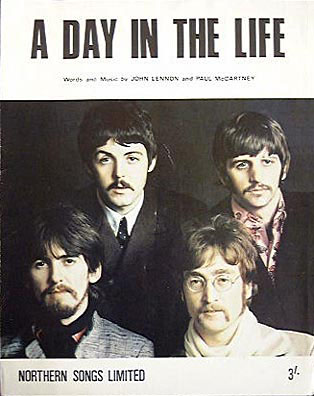 "Strawberry Fields Forever," for instance, was a chronicle of childhood memories, but he masked these in visual imagery to create a psychedelic musical landscape appropriate for the culture of that time. His contributed lyrics to "A Day In The Life" wove together various stories he had read in the newspaper into one experience, embellishing the events with his interpretation and wit. "Strawberry Fields Forever," for instance, was a chronicle of childhood memories, but he masked these in visual imagery to create a psychedelic musical landscape appropriate for the culture of that time. His contributed lyrics to "A Day In The Life" wove together various stories he had read in the newspaper into one experience, embellishing the events with his interpretation and wit.
This is also the case with the tale of “Polythene Pam.” As we'll see below, John combined memories of different events and wove them together into a detailed story that became yet another example of humorous fiction in song.
Songwriting History
"That's another half a song I wrote in India about a kinky girl in a polythene bag," Lennon stated shortly after its release. "It's a bit like everything...you know, 'Not Fade Away' (by The Crickets) and 'Summertime Blues' (by Eddie Cochran)." This quote places the time of writing at March of 1968 when The Beatles were in Rishekesh, India studying Transcendental Meditation with the Maharishi.
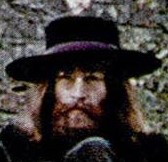 Describing this song along with “Mean Mr. Mustard” as “finished bits of crap,” John initially simplified his explanation of the meaning behind “Polythene Pam” as about “a mythical Liverpool scrubber dressed up in her jackboots and kilt.” What he meant by “scrubber” was a groupie or fan, possibly insinuating her being promiscuous. Describing this song along with “Mean Mr. Mustard” as “finished bits of crap,” John initially simplified his explanation of the meaning behind “Polythene Pam” as about “a mythical Liverpool scrubber dressed up in her jackboots and kilt.” What he meant by “scrubber” was a groupie or fan, possibly insinuating her being promiscuous.
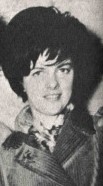 Undoubtedly, the fan that Lennon was referring to was Pat Dawson, known then as Pat Hodgett, who was a regular attendee at the Cavern Club when The Beatles played in the early '60s. It was commonly known that Pat was in the habit of eating polythene, this word being a British variant for polyethylene, a plastic material. Therefore, The Beatles affectionately referred to her as “Polythene Pat,” a name John remembered several years later (at least subconsciously) when writing "Polythene Pam." Undoubtedly, the fan that Lennon was referring to was Pat Dawson, known then as Pat Hodgett, who was a regular attendee at the Cavern Club when The Beatles played in the early '60s. It was commonly known that Pat was in the habit of eating polythene, this word being a British variant for polyethylene, a plastic material. Therefore, The Beatles affectionately referred to her as “Polythene Pat,” a name John remembered several years later (at least subconsciously) when writing "Polythene Pam."
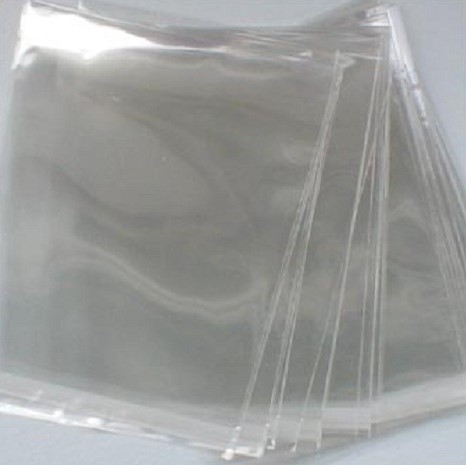 “I started going to see The Beatles in 1961 when I was fourteen,” Pat states in Steve Turner's book “A Hard Day's Write,” “and I got quite friendly with them. If they were playing out of town they'd give me a lift back home in their van. It was about the same time that I started getting called Polythene Pat. It's embarrassing really. I just used to eat polythene all the time. I'd tie it in knots and then eat it. Sometimes I even used to burn it and then eat it when it got cold. Then I had a friend who got a job in a polythene bag factory, which was wonderful because it meant I had a constant supply.” “I started going to see The Beatles in 1961 when I was fourteen,” Pat states in Steve Turner's book “A Hard Day's Write,” “and I got quite friendly with them. If they were playing out of town they'd give me a lift back home in their van. It was about the same time that I started getting called Polythene Pat. It's embarrassing really. I just used to eat polythene all the time. I'd tie it in knots and then eat it. Sometimes I even used to burn it and then eat it when it got cold. Then I had a friend who got a job in a polythene bag factory, which was wonderful because it meant I had a constant supply.”
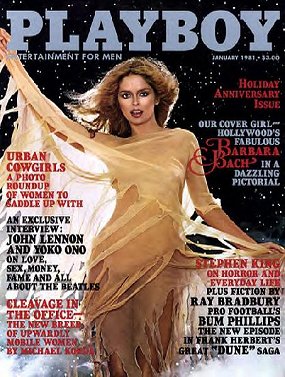 While the title “Polythene Pam” undoubtedly came from John's recollection of Polythene Pat Hodgett, there was another event obliquely referred to in the song that occurred on August 8th, 1963, while The Beatles were on tour in the Channel Islands. John gives us some interesting hints about the events of this day when asked about the authorship of “Polythene Pam” in his 1980 interview with Playboy Magazine. While the title “Polythene Pam” undoubtedly came from John's recollection of Polythene Pat Hodgett, there was another event obliquely referred to in the song that occurred on August 8th, 1963, while The Beatles were on tour in the Channel Islands. John gives us some interesting hints about the events of this day when asked about the authorship of “Polythene Pam” in his 1980 interview with Playboy Magazine.
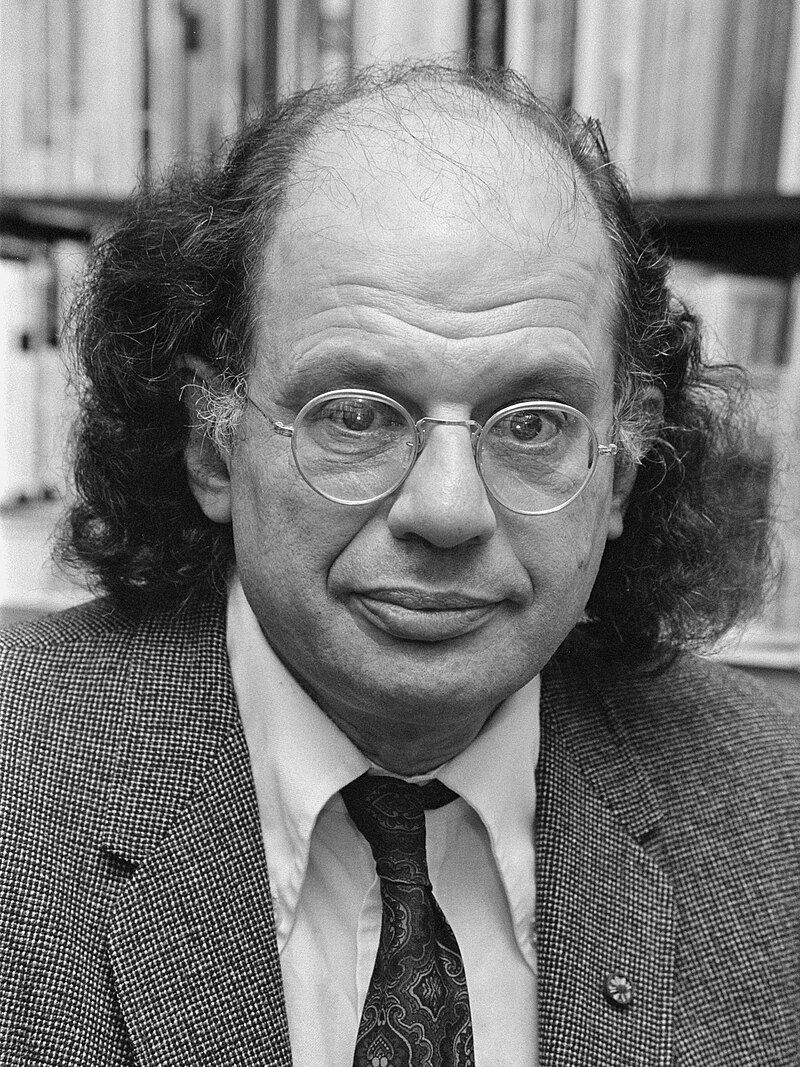 Therein he states: “That was me, remembering a little event I had with a woman in Jersey, an island off the French coast. A poet, England's answer to Allen Ginsberg, a beatnik that looked like a beatnik, who gave us our first exposure, who was from Liverpool, took me to this apartment of his in Jersey. This was so long ago. This is all triggering these amazing memories. So this poet took me to his place, and I had a girl and he had one he wanted me to meet. He said she dressed up in polythene, which she did. In polythene bags. She didn't wear jack boots and kilts – I just sort of elaborated – and no, she didn't really look like a man. There was nothing much to it. It was kind of perverted sex in a polythene bag. But it provided something to write a song about.” Therein he states: “That was me, remembering a little event I had with a woman in Jersey, an island off the French coast. A poet, England's answer to Allen Ginsberg, a beatnik that looked like a beatnik, who gave us our first exposure, who was from Liverpool, took me to this apartment of his in Jersey. This was so long ago. This is all triggering these amazing memories. So this poet took me to his place, and I had a girl and he had one he wanted me to meet. He said she dressed up in polythene, which she did. In polythene bags. She didn't wear jack boots and kilts – I just sort of elaborated – and no, she didn't really look like a man. There was nothing much to it. It was kind of perverted sex in a polythene bag. But it provided something to write a song about.”
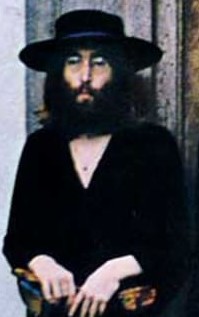 And now to unravel the mystery! This poet that John describes as “England's answer to Allen Ginsberg” was a young writer by the name of Royston Ellis. He first met The Beatles in May or June of 1960 when he was invited to read poetry at Liverpool University. Royston Ellis gave The Beatles their “first exposure” by arranging for them to back his poetry reading at a beat music event at the Jacaranda Club in July of 1960. Afterwards, an article in a July 9th, 1960 edition of the music paper "Record And Show Mirror" stated that Royston Ellis was "thinking of bringing down to London a Liverpool group which he considers is most in accord with his poetry. Name of the group? 'The Beetles'!" “I was quite a star for them at that time,” Royston Ellis stated in the book “A Hard Day's Write,” “because I had come up from London and that was a world they didn't really know about. I stayed with them for about a week in their flat at Gambier Terrace during that 1960 visit. John was fascinated by the fact that I was a poet and that led to deep conversations.” And now to unravel the mystery! This poet that John describes as “England's answer to Allen Ginsberg” was a young writer by the name of Royston Ellis. He first met The Beatles in May or June of 1960 when he was invited to read poetry at Liverpool University. Royston Ellis gave The Beatles their “first exposure” by arranging for them to back his poetry reading at a beat music event at the Jacaranda Club in July of 1960. Afterwards, an article in a July 9th, 1960 edition of the music paper "Record And Show Mirror" stated that Royston Ellis was "thinking of bringing down to London a Liverpool group which he considers is most in accord with his poetry. Name of the group? 'The Beetles'!" “I was quite a star for them at that time,” Royston Ellis stated in the book “A Hard Day's Write,” “because I had come up from London and that was a world they didn't really know about. I stayed with them for about a week in their flat at Gambier Terrace during that 1960 visit. John was fascinated by the fact that I was a poet and that led to deep conversations.”
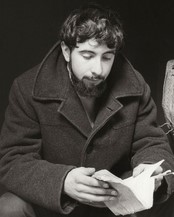 While on tour in August of 1963, The Beatles met up with Royston Ellis once again. However, a correction needs to be made concerning the location of their meet-up. This actually took place on the Channel island of Guernsey, not Jersey as John mentioned in the Playboy interview. Photographic evidence shows a bearded Royston Ellis posing with The Beatles during their visit to Guernsey on August 8th, 1963. Royston Ellis had a summer job there as a ferry boat engineer and arranged to meet up with John at the attic apartment he was renting after The Beatles performance on that day. While on tour in August of 1963, The Beatles met up with Royston Ellis once again. However, a correction needs to be made concerning the location of their meet-up. This actually took place on the Channel island of Guernsey, not Jersey as John mentioned in the Playboy interview. Photographic evidence shows a bearded Royston Ellis posing with The Beatles during their visit to Guernsey on August 8th, 1963. Royston Ellis had a summer job there as a ferry boat engineer and arranged to meet up with John at the attic apartment he was renting after The Beatles performance on that day.
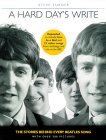 In the early '90s, Royston Ellis was interviewed by author Steve Turner for his book “A Hard Day's Write” so as to get the full story of the events of this day. Being so removed from the British music scene throughout the years, he had no knowledge of the song “Polythene Pam,” but recalls the events of August 8th, 1963 that took place with his then girlfriend, now remembered only by the name Stephanie. In the early '90s, Royston Ellis was interviewed by author Steve Turner for his book “A Hard Day's Write” so as to get the full story of the events of this day. Being so removed from the British music scene throughout the years, he had no knowledge of the song “Polythene Pam,” but recalls the events of August 8th, 1963 that took place with his then girlfriend, now remembered only by the name Stephanie.
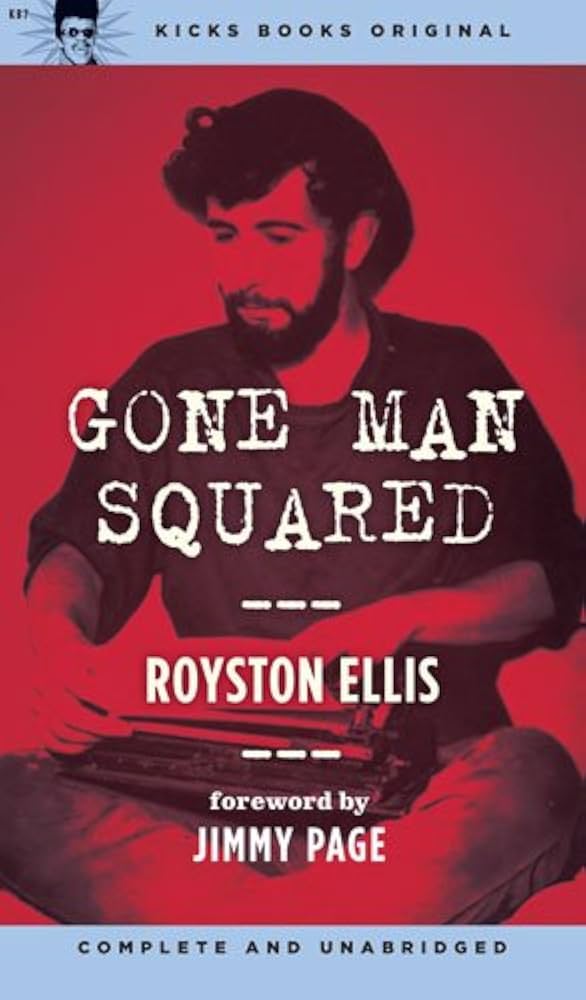 Royston Ellis relates: “We'd read all these things about leather and we didn't have any leather but I had my oilskins and we had some polythene bags from somewhere. We all dressed up in them and wore them in bed. John stayed the night with us in the same bed. I don't think anything very exciting happened and we all wondered what the fun was in being 'kinky.' It was probably more my idea than John's. It could have all happened because in a poetry booklet of mine which I had dedicated to The Beatles there was a poem with the lines: 'I long to have sex between black leather sheets, and ride shivering motorcycles between your thighs.' I can't really remember everything that happened. At the time, it meant nothing to me. It was just one event during a very eventful time of my life.” Royston Ellis relates: “We'd read all these things about leather and we didn't have any leather but I had my oilskins and we had some polythene bags from somewhere. We all dressed up in them and wore them in bed. John stayed the night with us in the same bed. I don't think anything very exciting happened and we all wondered what the fun was in being 'kinky.' It was probably more my idea than John's. It could have all happened because in a poetry booklet of mine which I had dedicated to The Beatles there was a poem with the lines: 'I long to have sex between black leather sheets, and ride shivering motorcycles between your thighs.' I can't really remember everything that happened. At the time, it meant nothing to me. It was just one event during a very eventful time of my life.”
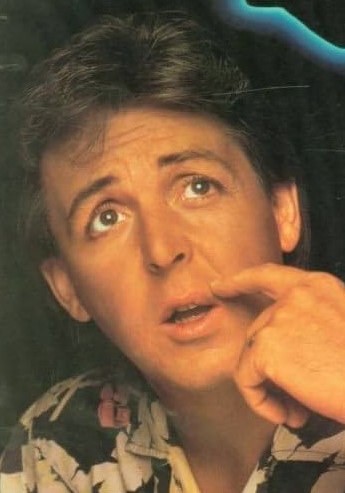 Paul never claimed any authorship for “Polythene Pam,” but recalls the events of August 8th, 1963. In his book “Many Years From Now,” he writes: “John, being Royston's friend, went out to dinner with him and got pissed (drunk) and stuff and they ended up back at his apartment with a girl who dressed herself in polythene for John's amusement, so it was a little kinky scene...She was a real character.” Paul never claimed any authorship for “Polythene Pam,” but recalls the events of August 8th, 1963. In his book “Many Years From Now,” he writes: “John, being Royston's friend, went out to dinner with him and got pissed (drunk) and stuff and they ended up back at his apartment with a girl who dressed herself in polythene for John's amusement, so it was a little kinky scene...She was a real character.”
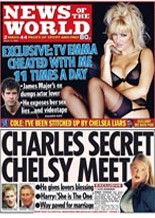 The “Polythene Pam” lyric “she's the kind of a girl that makes the news of the world” has an interesting explanation as well. “News Of The World” was a popular British newspaper that was notable for printing articles about sex scandals and other provocative topics regarding celebrities. Therefore, the supposed “perverted sex in a polythene bag” that Lennon alludes to have occurred between himself, Ellis and his girlfriend Stephanie would surely be fodder for this publication. The “Polythene Pam” lyric “she's the kind of a girl that makes the news of the world” has an interesting explanation as well. “News Of The World” was a popular British newspaper that was notable for printing articles about sex scandals and other provocative topics regarding celebrities. Therefore, the supposed “perverted sex in a polythene bag” that Lennon alludes to have occurred between himself, Ellis and his girlfriend Stephanie would surely be fodder for this publication.
Being that Royston Ellis was the first published author The Beatles had met, he firmly suggests that he even inspired Paul to compose the Beatles hit “Paperback Writer,” although this has never been confirmed.
Recording History
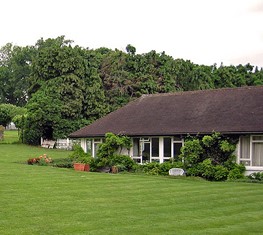 On May 28th, 1968, The Beatles gathered at George's 'Kinfauns' home in Esher, Surrey to tape demo recordings of songs they wanted to officially record for their next album, which became the "White Album." Having recently spent a few weeks in Rishikesh, India with the Maharishi, they had written a bumper crop of new songs and, with their first EMI recording session for this new album occurring on May 30th of that year, they wanted to premier these new songs to the rest of the group. On May 28th, 1968, The Beatles gathered at George's 'Kinfauns' home in Esher, Surrey to tape demo recordings of songs they wanted to officially record for their next album, which became the "White Album." Having recently spent a few weeks in Rishikesh, India with the Maharishi, they had written a bumper crop of new songs and, with their first EMI recording session for this new album occurring on May 30th of that year, they wanted to premier these new songs to the rest of the group.
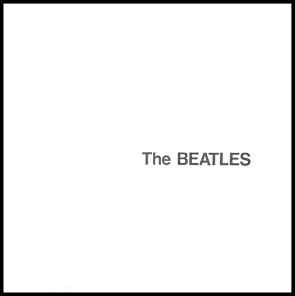 John in particular had used his quiet time in India to write a plethora of songs, the majority of which ended up on the “White Album.” However, a few didn't, and remained undeveloped for the time being, the only tangible evidence of these few having been committed to tape on George's Ampex four-track tape machine on this day. One of these was “Polythene Pam.” John in particular had used his quiet time in India to write a plethora of songs, the majority of which ended up on the “White Album.” However, a few didn't, and remained undeveloped for the time being, the only tangible evidence of these few having been committed to tape on George's Ampex four-track tape machine on this day. One of these was “Polythene Pam.”
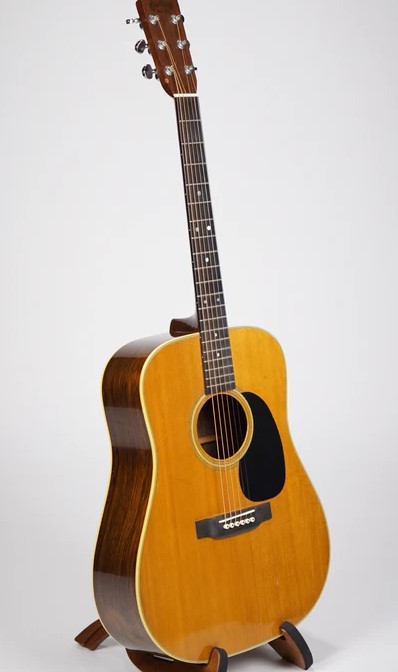 This rough demo was performed by John alone on acoustic guitar and vocals, both of these being double-tracked by the author to fill up all four-tracks of the tape. The arrangement of the song at this point consisted of the two verses that ended up on the released version, John then repeating both of these verses and then repeating the second verse yet another time. John alternated a line in the second verse between the above mentioned reference to Pam being a candidate for “the News Of The World” with the lyric “Well, it's a little absurd but she's a nice class of bird.” Interestingly, when double-tracking his vocals on the final repeat of the second verse, he confused these lines and ended up completing the song in lyrical gibberish. Another noticeable difference is how John repeats the final line of each verse at the end, something he replaced in the final recording with a “She Loves You” reprise of “yeah, yeah, yeah.” This demo, however, ends with John prayerfully exclaiming “Amen.” This rough demo was performed by John alone on acoustic guitar and vocals, both of these being double-tracked by the author to fill up all four-tracks of the tape. The arrangement of the song at this point consisted of the two verses that ended up on the released version, John then repeating both of these verses and then repeating the second verse yet another time. John alternated a line in the second verse between the above mentioned reference to Pam being a candidate for “the News Of The World” with the lyric “Well, it's a little absurd but she's a nice class of bird.” Interestingly, when double-tracking his vocals on the final repeat of the second verse, he confused these lines and ended up completing the song in lyrical gibberish. Another noticeable difference is how John repeats the final line of each verse at the end, something he replaced in the final recording with a “She Loves You” reprise of “yeah, yeah, yeah.” This demo, however, ends with John prayerfully exclaiming “Amen.”
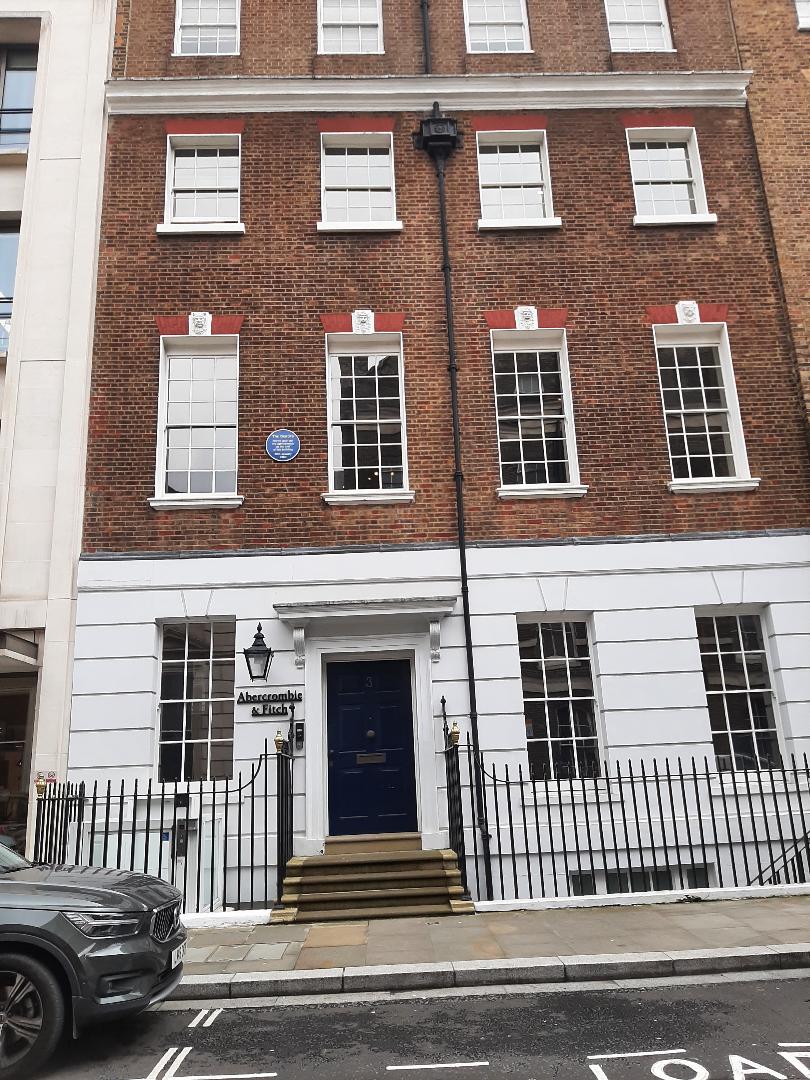 Having been omitted from the lineup for the “White Album,” John resurrected the song in the rehearsals for their next project, this eventually becoming the “Let It Be” film and soundtrack album. John rehearsed “Polythene Pam” with The Beatles on January 24th, 1969 at Apple Studios at 3 Savile Row, London during their rehearsals for the song "Two Of Us." Just after they had all ordered lunch, John ran through a very rough rendition of the two existing verses of the song, apparently re-learning it as he went along. Paul briefly joins in on vocals while Ringo and George also chime in on their instruments as well. After the song dissolves, John makes the comment “I'll give that to somebody...I'll give that to some Liverpool folk singer.” The group apparently didn't feel inclined to perfect the song for consideration for this project, it being once again put on the shelf for the indefinite future with the possibility of handing it off to another artist to record. This impromptu recording received an official release in 2021, as we'll see below. Having been omitted from the lineup for the “White Album,” John resurrected the song in the rehearsals for their next project, this eventually becoming the “Let It Be” film and soundtrack album. John rehearsed “Polythene Pam” with The Beatles on January 24th, 1969 at Apple Studios at 3 Savile Row, London during their rehearsals for the song "Two Of Us." Just after they had all ordered lunch, John ran through a very rough rendition of the two existing verses of the song, apparently re-learning it as he went along. Paul briefly joins in on vocals while Ringo and George also chime in on their instruments as well. After the song dissolves, John makes the comment “I'll give that to somebody...I'll give that to some Liverpool folk singer.” The group apparently didn't feel inclined to perfect the song for consideration for this project, it being once again put on the shelf for the indefinite future with the possibility of handing it off to another artist to record. This impromptu recording received an official release in 2021, as we'll see below.
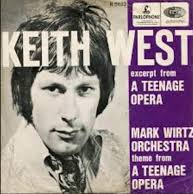 Then, sometime in May of 1969, Paul came up with the idea of stringing together leftover bits of songs that he and John had into one long montage to be used as a whole side of their final album. “I wanted to do something bigger, a kind of operatic moment,” Paul explained to Mark Lewisohn in the forward of his book “The Beatles Recording Sessions.” “There were a few people doing that. 'Teenage Opera' was one. We wanted to dabble and I had a bit of fun making some of the songs fit together, with the key changes. That was nice, it worked out well.” Paul here refers to the popular Keith West 1968 release “Excerpt From A Teenage Opera,” this being sited as a key inspiration to what became the “Abbey Road” medley. Then, sometime in May of 1969, Paul came up with the idea of stringing together leftover bits of songs that he and John had into one long montage to be used as a whole side of their final album. “I wanted to do something bigger, a kind of operatic moment,” Paul explained to Mark Lewisohn in the forward of his book “The Beatles Recording Sessions.” “There were a few people doing that. 'Teenage Opera' was one. We wanted to dabble and I had a bit of fun making some of the songs fit together, with the key changes. That was nice, it worked out well.” Paul here refers to the popular Keith West 1968 release “Excerpt From A Teenage Opera,” this being sited as a key inspiration to what became the “Abbey Road” medley.
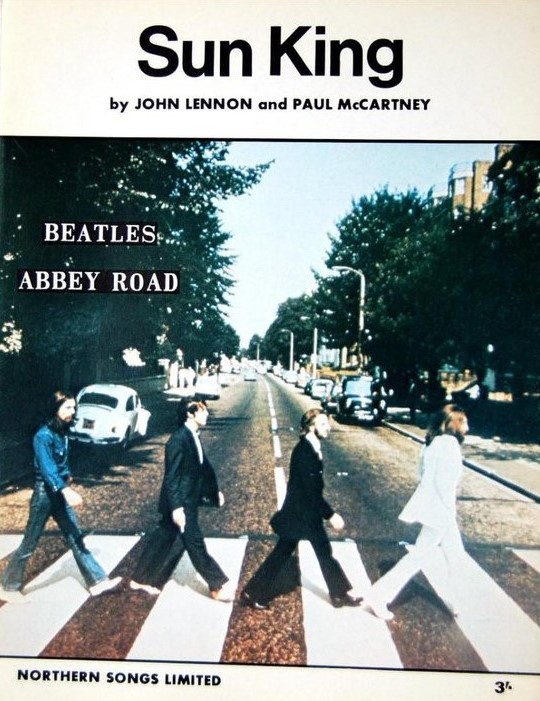 John contributed three unfinished ideas to this medley, the recently written “Sun King” and two unfinished pieces from the “White Album” era, namely “Mean Mr. Mustard” and “Polythene Pam.” John explained at the time how his and Paul's contributions were arranged while constructing this montage: “George and Ringo, in fact, wrote bits of it and we did it, you know. Literally, in-between bits and breaks into it, Paul would say, 'We've got 12 bars here, let's fill it in.' And we'd fill it in on the spot.” John contributed three unfinished ideas to this medley, the recently written “Sun King” and two unfinished pieces from the “White Album” era, namely “Mean Mr. Mustard” and “Polythene Pam.” John explained at the time how his and Paul's contributions were arranged while constructing this montage: “George and Ringo, in fact, wrote bits of it and we did it, you know. Literally, in-between bits and breaks into it, Paul would say, 'We've got 12 bars here, let's fill it in.' And we'd fill it in on the spot.”
 This arrangement idea was put in place by the band to link John's “Polythene Pam” with Paul's song “She Came In Through The Bathroom Window,” both songs being recorded as one. Other than the “Sgt. Pepper” classic “A Day In The Life,” this was the first time two distinct songs from John and Paul were spliced together and recorded together, the linking arrangement being put together by The Beatles as a whole on this occasion. This recording began on July 25th, 1969 in EMI Studio Two, the session beginning at 2:30 pm. This arrangement idea was put in place by the band to link John's “Polythene Pam” with Paul's song “She Came In Through The Bathroom Window,” both songs being recorded as one. Other than the “Sgt. Pepper” classic “A Day In The Life,” this was the first time two distinct songs from John and Paul were spliced together and recorded together, the linking arrangement being put together by The Beatles as a whole on this occasion. This recording began on July 25th, 1969 in EMI Studio Two, the session beginning at 2:30 pm.
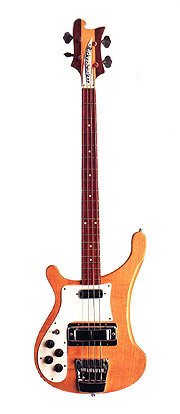 This twelve-hour session began with overdubs being recorded onto another section of the montage, namely the “Sun King / Mean Mr. Mustard” medley which had been started the day before, and John's “Come Together.” After this, starting at about 4:30 pm, the group took to spending the rest of this long session recording the rhythm track to the newly arranged medley of “Polythene Pam / She Came In Through The Bathroom Window,” undoubtedly perfecting the linking section of these two songs in the process. The instrumentation was Paul on Rickenbacker bass (track one), Ringo on drums (track two), John on acoustic 12-string guitar (track three), George on lead guitar (track four) and John's guide vocals (track six). This twelve-hour session began with overdubs being recorded onto another section of the montage, namely the “Sun King / Mean Mr. Mustard” medley which had been started the day before, and John's “Come Together.” After this, starting at about 4:30 pm, the group took to spending the rest of this long session recording the rhythm track to the newly arranged medley of “Polythene Pam / She Came In Through The Bathroom Window,” undoubtedly perfecting the linking section of these two songs in the process. The instrumentation was Paul on Rickenbacker bass (track one), Ringo on drums (track two), John on acoustic 12-string guitar (track three), George on lead guitar (track four) and John's guide vocals (track six).
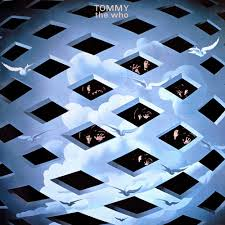 Of the 39 takes of the rhythm track that were recorded during this session, "take 27" is included on various 50th Anniversary editions of "Abbey Road." Before this take begins, Paul instructs the others: "If you don't do so much to start off with, 'cause you blow it all, you know what I mean, you give away all your best bits. What are you doing at the beginning?" John inquires as to which Beatle he's talking to, as Paul vocalizes John's opening acoustic guitar strums. This prompts George and Ringo to demonstrate their parts, the drummer then continuing his tom-heavy drum playing. When Paul rallies them in for another take, John laughingly states that Ringo's drumming "sounds like Dave Clark." Then, before robustly counting off the next take, he refers to his heavy acoustic guitar intro by saying, "It's like being 'Tommy' in here!" The Who's classic rock opera "Tommy," featuring the somewhat similarly introduced "Pinball Wizard," had just been released a few weeks before this session and, therefore, was fresh on everyone's minds. "Take 27" was performed well except for George's ad lib guitar solo that concludes the song, this not being fully worked out as of yet. John flubs the lyrics in places, knowing that these would be improved upon later as an overdub. A total of 39 takes were needed to get it to everyone's satisfaction, "take 39" being deemed the best, which included a very well-performed guitar solo from George. This session was complete by 10:30 pm. Of the 39 takes of the rhythm track that were recorded during this session, "take 27" is included on various 50th Anniversary editions of "Abbey Road." Before this take begins, Paul instructs the others: "If you don't do so much to start off with, 'cause you blow it all, you know what I mean, you give away all your best bits. What are you doing at the beginning?" John inquires as to which Beatle he's talking to, as Paul vocalizes John's opening acoustic guitar strums. This prompts George and Ringo to demonstrate their parts, the drummer then continuing his tom-heavy drum playing. When Paul rallies them in for another take, John laughingly states that Ringo's drumming "sounds like Dave Clark." Then, before robustly counting off the next take, he refers to his heavy acoustic guitar intro by saying, "It's like being 'Tommy' in here!" The Who's classic rock opera "Tommy," featuring the somewhat similarly introduced "Pinball Wizard," had just been released a few weeks before this session and, therefore, was fresh on everyone's minds. "Take 27" was performed well except for George's ad lib guitar solo that concludes the song, this not being fully worked out as of yet. John flubs the lyrics in places, knowing that these would be improved upon later as an overdub. A total of 39 takes were needed to get it to everyone's satisfaction, "take 39" being deemed the best, which included a very well-performed guitar solo from George. This session was complete by 10:30 pm.
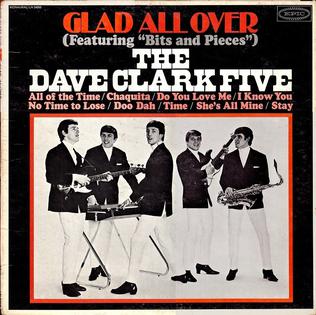 John was apparently the hardest to please at this session, as related by engineer Geoff Emerick in his book “Here, There And Everywhere.” “Things weren't quite so pleasant,” Emerick recalls, adding: “John was unhappy with Ringo's drumming, commenting acidly at one point that it 'sounded like Dave Clark (of The Dave Clark Five),' which was clearly not meant as a compliment. He was so impatient at Ringo's inability to come up with a suitable part that he finally said, 'Sod it, let's just put one down anyway.' But Ringo was upset that John was unhappy with his drumming, and he spent a good deal of time working on it with Paul even after the backing track was done. Finally, he said to John, 'Why don't we just record the backing track again? I think I've got a part you'll like now,' but Lennon waved him off. 'I'm not playing the bloody song again, Ring. If you want to redo the drums, go ahead and overdub them.'” John was apparently the hardest to please at this session, as related by engineer Geoff Emerick in his book “Here, There And Everywhere.” “Things weren't quite so pleasant,” Emerick recalls, adding: “John was unhappy with Ringo's drumming, commenting acidly at one point that it 'sounded like Dave Clark (of The Dave Clark Five),' which was clearly not meant as a compliment. He was so impatient at Ringo's inability to come up with a suitable part that he finally said, 'Sod it, let's just put one down anyway.' But Ringo was upset that John was unhappy with his drumming, and he spent a good deal of time working on it with Paul even after the backing track was done. Finally, he said to John, 'Why don't we just record the backing track again? I think I've got a part you'll like now,' but Lennon waved him off. 'I'm not playing the bloody song again, Ring. If you want to redo the drums, go ahead and overdub them.'”
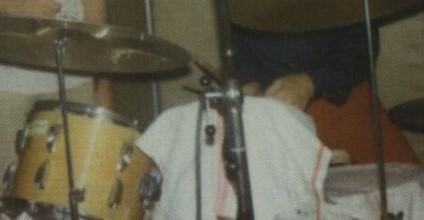 “That night, Ringo did just that. Fortunately we were working in eight-track, so I was able to record the new drum track without erasing the old one. It took many hours to do, but Ringo eventually pulled it off, managing to play the new drum part from start to finish without losing the beat...and those were the days before we had click tracks, so his only reference was the original drum track, which we fed to him through headphones.” “That night, Ringo did just that. Fortunately we were working in eight-track, so I was able to record the new drum track without erasing the old one. It took many hours to do, but Ringo eventually pulled it off, managing to play the new drum part from start to finish without losing the beat...and those were the days before we had click tracks, so his only reference was the original drum track, which we fed to him through headphones.”
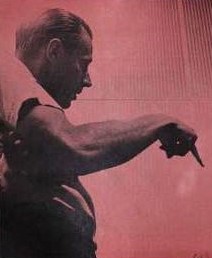 These drums, as well as other overdubs for the song, were recorded between 10:30 pm and 2:30 am the following morning. The other overdubs consisted of John's lead vocals and Paul re-recording his bass part. Geoff Emerick continues: “Paul overdubbed his bass on 'Polythene Pam,' and at one point he overshot the note on one of his glissandos. Instinctively, he said, 'Oops, let me drop that in and fix it,' but we all spontaneously overruled him, saying, 'No, it's great! Leave it in' – even George Martin got into the spirit of things. When someone made a mistake like that and the others liked it, we'd often actually make it louder when we'd mix the song so as to accentuate it. Sometimes we'd even double-track the mistake with different instruments so it would be even more obvious. It was all about playing a joke on the fans, giving them a treat, something to talk about. That's what we did on 'Polythene Pam': Paul's overshoot actually became a feature.” These drums, as well as other overdubs for the song, were recorded between 10:30 pm and 2:30 am the following morning. The other overdubs consisted of John's lead vocals and Paul re-recording his bass part. Geoff Emerick continues: “Paul overdubbed his bass on 'Polythene Pam,' and at one point he overshot the note on one of his glissandos. Instinctively, he said, 'Oops, let me drop that in and fix it,' but we all spontaneously overruled him, saying, 'No, it's great! Leave it in' – even George Martin got into the spirit of things. When someone made a mistake like that and the others liked it, we'd often actually make it louder when we'd mix the song so as to accentuate it. Sometimes we'd even double-track the mistake with different instruments so it would be even more obvious. It was all about playing a joke on the fans, giving them a treat, something to talk about. That's what we did on 'Polythene Pam': Paul's overshoot actually became a feature.”
 Finally, at 2:30 am, the session was complete. “For all of the kerfuffle, they were fun tracks to record,” Geoff Emerick relates. “The ensemble playing was superb. Sitting up in the Studio Two control room, I commented to George Martin that it sounded like old-style Beatles, like the four of them playing together as a band circa 1963. 'You're right,' George said sardonically. 'You'd never guess that the four of them actually can't stand each other.'” Finally, at 2:30 am, the session was complete. “For all of the kerfuffle, they were fun tracks to record,” Geoff Emerick relates. “The ensemble playing was superb. Sitting up in the Studio Two control room, I commented to George Martin that it sounded like old-style Beatles, like the four of them playing together as a band circa 1963. 'You're right,' George said sardonically. 'You'd never guess that the four of them actually can't stand each other.'”
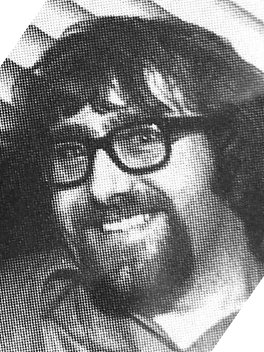 Their next session, which was on July 28th, 1969 in EMI Studio Three, focused exclusively on adding more overdubs onto “Polythene Pam / She Came In Through The Bathroom Window.” This session also began at 2:30 pm and resulted in various overdubs on “Polythene Pam,” such as tambourine, maracas and cowbell from Ringo, electric guitar from George playing the descending single-string notes that segue the first song into the second song, and both acoustic and electric piano from Paul. This piano work, however, is very low in the mix and not detected in the finished product. John also once again re-recorded his lead vocal, this time in a noticeable Scouse accent that continues as an ad lib during George's concluding guitar solo. "Fab," he states, "Isn't that great? It's real good, that, real good, listen to that Mal," referring to assistant Mal Evans who was present at the session. Then, as the segue into "She Came In Through The Bathroom Window" is progressing, John shouts, "Oh, look out!" The tail end of this vocalization ended up on the finished recording. Their next session, which was on July 28th, 1969 in EMI Studio Three, focused exclusively on adding more overdubs onto “Polythene Pam / She Came In Through The Bathroom Window.” This session also began at 2:30 pm and resulted in various overdubs on “Polythene Pam,” such as tambourine, maracas and cowbell from Ringo, electric guitar from George playing the descending single-string notes that segue the first song into the second song, and both acoustic and electric piano from Paul. This piano work, however, is very low in the mix and not detected in the finished product. John also once again re-recorded his lead vocal, this time in a noticeable Scouse accent that continues as an ad lib during George's concluding guitar solo. "Fab," he states, "Isn't that great? It's real good, that, real good, listen to that Mal," referring to assistant Mal Evans who was present at the session. Then, as the segue into "She Came In Through The Bathroom Window" is progressing, John shouts, "Oh, look out!" The tail end of this vocalization ended up on the finished recording.
 This recording session was complete at 8 pm, but they still felt more was needed to get this section of the medley to a completed state. Therefore, between 8 and 8:30 pm, a reduction mix was made by the engineering staff (George Martin and engineers Geoff Emerick, Phil McDonald and John Kurlander) in order to open up more tracks for additional overdubs which would be performed at a later time. This reduction mix took "take 39" to "take 40." This recording session was complete at 8 pm, but they still felt more was needed to get this section of the medley to a completed state. Therefore, between 8 and 8:30 pm, a reduction mix was made by the engineering staff (George Martin and engineers Geoff Emerick, Phil McDonald and John Kurlander) in order to open up more tracks for additional overdubs which would be performed at a later time. This reduction mix took "take 39" to "take 40."
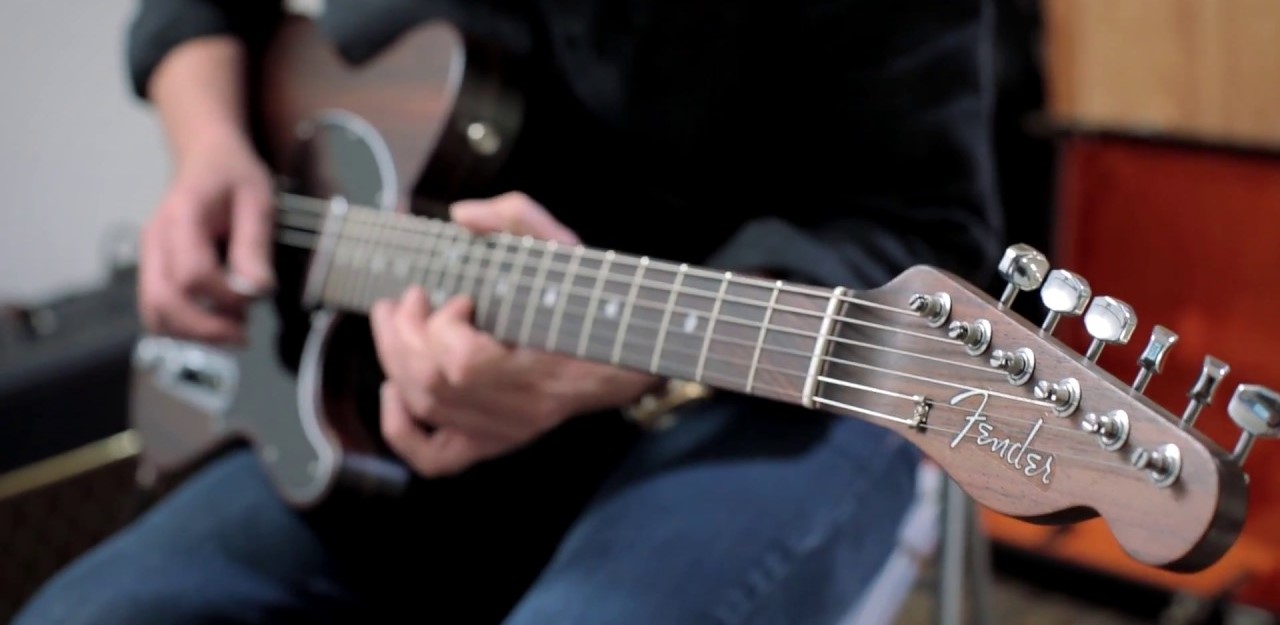 The Beatles added their final overdubs to “Polythene Pam” on July 30th, 1969, in EMI Studio Three, this session beginning at 3:30 pm. After they concentrated on performing overdubs onto “Come Together,” John, Paul and George added their background vocals to “Polythene Pam” at this time along with, as documentation shows, more percussion and guitar, although these later overdubs may be concerning the “Bathroom Window” section of this composite recording. With this complete, they added overdubs to other segments of the long medley before the session ended at 10:30 pm. The Beatles added their final overdubs to “Polythene Pam” on July 30th, 1969, in EMI Studio Three, this session beginning at 3:30 pm. After they concentrated on performing overdubs onto “Come Together,” John, Paul and George added their background vocals to “Polythene Pam” at this time along with, as documentation shows, more percussion and guitar, although these later overdubs may be concerning the “Bathroom Window” section of this composite recording. With this complete, they added overdubs to other segments of the long medley before the session ended at 10:30 pm.
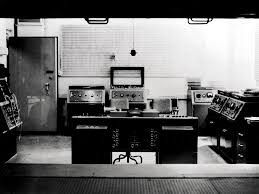 However, everyone immediately moved into the control room of EMI Studio Two on this evening to put together a preliminary edit to find out how the long medley would sound in its finished state. The first order of business was to create workable stereo mixes for all of the medley songs so they could be spliced together, this being done by George Martin and engineers Geoff Emerick, Phil McDonald and John Kurlander. These were all rough preliminary mixes, however, which would be improved upon when the actual assembling of the medley components was to officially be done. However, everyone immediately moved into the control room of EMI Studio Two on this evening to put together a preliminary edit to find out how the long medley would sound in its finished state. The first order of business was to create workable stereo mixes for all of the medley songs so they could be spliced together, this being done by George Martin and engineers Geoff Emerick, Phil McDonald and John Kurlander. These were all rough preliminary mixes, however, which would be improved upon when the actual assembling of the medley components was to officially be done.
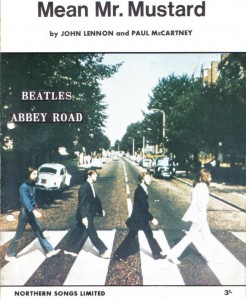 After these rough mixes were created, the engineering team, with input from The Beatles, edited and compiled all of the segments into one long preliminary medley for the first time. Interestingly, Paul's slight acoustic guitar piece “Her Majesty” was included between “Mean Mr. Mustard” and “Polythene Pam” at this point. Upon listening to the completed medley on this day, Paul decided to scrap “Her Majesty,” asking it to be physically cut out of this assembled tape and to then splice together the end of “Mean Mr. Mustard” to the beginning of “Polythene Pam.” This more natural segue became the official running order of the medley at this point, although the true stereo mix of this medley as we know it wasn't assembled as of yet. By 2:30 am the following morning, this recording / editing / compilation session was complete. After these rough mixes were created, the engineering team, with input from The Beatles, edited and compiled all of the segments into one long preliminary medley for the first time. Interestingly, Paul's slight acoustic guitar piece “Her Majesty” was included between “Mean Mr. Mustard” and “Polythene Pam” at this point. Upon listening to the completed medley on this day, Paul decided to scrap “Her Majesty,” asking it to be physically cut out of this assembled tape and to then splice together the end of “Mean Mr. Mustard” to the beginning of “Polythene Pam.” This more natural segue became the official running order of the medley at this point, although the true stereo mix of this medley as we know it wasn't assembled as of yet. By 2:30 am the following morning, this recording / editing / compilation session was complete.
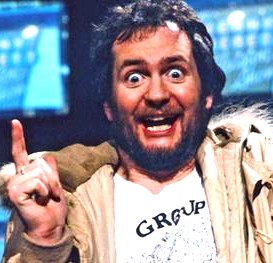 The true stereo mix that was used on the released recording was done on August 14th, 1969 in the control room of EMI Studio Two, this session beginning at 2:30 pm. The engineering team of George Martin, Geoff Emerick, Phil McDonald and Alan Parsons made 13 attempts at creating this stereo mix, the final one, called 'take 32,' being deemed the best. Stereo mixes of other “Abbey Road” tracks were made on this day, as well as a John Lennon interview with radio personality Kenny Everett, after which the editing of the newly created stereo mixes of “Sun King / Mean Mr. Mustard / Polythene Pam / She Came In Through The Bathroom Window” were joined together seamlessly as heard on the finished album. By 2:30 am the following morning, this session was complete, which brought “Polythene Pam” to its finished state as heard on the released “Abbey Road.” The true stereo mix that was used on the released recording was done on August 14th, 1969 in the control room of EMI Studio Two, this session beginning at 2:30 pm. The engineering team of George Martin, Geoff Emerick, Phil McDonald and Alan Parsons made 13 attempts at creating this stereo mix, the final one, called 'take 32,' being deemed the best. Stereo mixes of other “Abbey Road” tracks were made on this day, as well as a John Lennon interview with radio personality Kenny Everett, after which the editing of the newly created stereo mixes of “Sun King / Mean Mr. Mustard / Polythene Pam / She Came In Through The Bathroom Window” were joined together seamlessly as heard on the finished album. By 2:30 am the following morning, this session was complete, which brought “Polythene Pam” to its finished state as heard on the released “Abbey Road.”
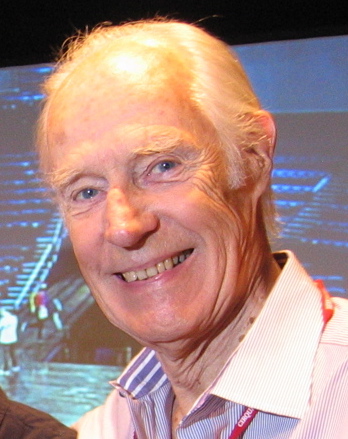 Sometime in 1996, George Martin and Geoff Emerick were given the original demo of “Polythene Pam” as recorded at George Harrison's 'Kinfauns' home on May 28th, 1968. From this, they created a clear mix for inclusion on the compilation album “Anthology 3,” which allows die-hard Beatles fans to examine the song's evolution from original conception to completed state. This demo was also included on various 50th Anniversary editions of the "White Album," with a new stereo mix being created by George Martin's son Giles Martin, along with engineer Sam Okell, sometime in 2018. Sometime in 1996, George Martin and Geoff Emerick were given the original demo of “Polythene Pam” as recorded at George Harrison's 'Kinfauns' home on May 28th, 1968. From this, they created a clear mix for inclusion on the compilation album “Anthology 3,” which allows die-hard Beatles fans to examine the song's evolution from original conception to completed state. This demo was also included on various 50th Anniversary editions of the "White Album," with a new stereo mix being created by George Martin's son Giles Martin, along with engineer Sam Okell, sometime in 2018.
 Giles Martin and Sam Okell also returned to the master tape of "Polythene Pam" sometime in 2019 to create a new stereo mix of the song for inclusion in various 50th Anniversary releases of "Abbey Road." While they were at it, they also created a stereo mix of "take 27" of the song as recorded on July 25th, 1969, complete with Beatles chat before the take began, and also the trial edit and mix from July 30th, 1969 of the entire "Abbey Road" medley, complete with John's entire Scouce-accented vocalizations at the conclusion of "Polythene Pam." Giles Martin and Sam Okell also returned to the master tape of "Polythene Pam" sometime in 2019 to create a new stereo mix of the song for inclusion in various 50th Anniversary releases of "Abbey Road." While they were at it, they also created a stereo mix of "take 27" of the song as recorded on July 25th, 1969, complete with Beatles chat before the take began, and also the trial edit and mix from July 30th, 1969 of the entire "Abbey Road" medley, complete with John's entire Scouce-accented vocalizations at the conclusion of "Polythene Pam."
 Sometime in 2021, Giles Martin and Sam Okell also took to creating new mixes for an Anniversary version of the "Let It Be" album. They thought the above mentioned January 24th, 1969 impromptu recording of "Polythene Pam" at Apple Studios would be an interesing inclusion for the "Super Deluxe" editions, complete with their lunch order of "whatever vegetables there are" and "cheese sauce for the cauliflower" as a special request for George. Sometime in 2021, Giles Martin and Sam Okell also took to creating new mixes for an Anniversary version of the "Let It Be" album. They thought the above mentioned January 24th, 1969 impromptu recording of "Polythene Pam" at Apple Studios would be an interesing inclusion for the "Super Deluxe" editions, complete with their lunch order of "whatever vegetables there are" and "cheese sauce for the cauliflower" as a special request for George.
Song Structure and Style
This small but effective segment of the "Abbey Road" medley consists simply of two verses and an instrumental section, parsed out as 'verse/ verse/ instrumental' (or aab).
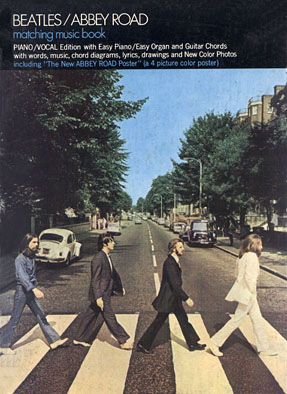 The first verse is fourteen measures long, these measures including the distinctive four-measure riff which consists primarily of John's three stabbing acoustic guitar chords that are repeated twice. Directly following both sets of acoustic guitar chords, George slides up and down the neck to play a quick electric guitar figure that consists of a chord played four times in rapid succession while Ringo pounds out these four beats on his toms. Paul also accentuates these notes on bass while letting the note ring out in the fourth measure. The first verse is fourteen measures long, these measures including the distinctive four-measure riff which consists primarily of John's three stabbing acoustic guitar chords that are repeated twice. Directly following both sets of acoustic guitar chords, George slides up and down the neck to play a quick electric guitar figure that consists of a chord played four times in rapid succession while Ringo pounds out these four beats on his toms. Paul also accentuates these notes on bass while letting the note ring out in the fourth measure.
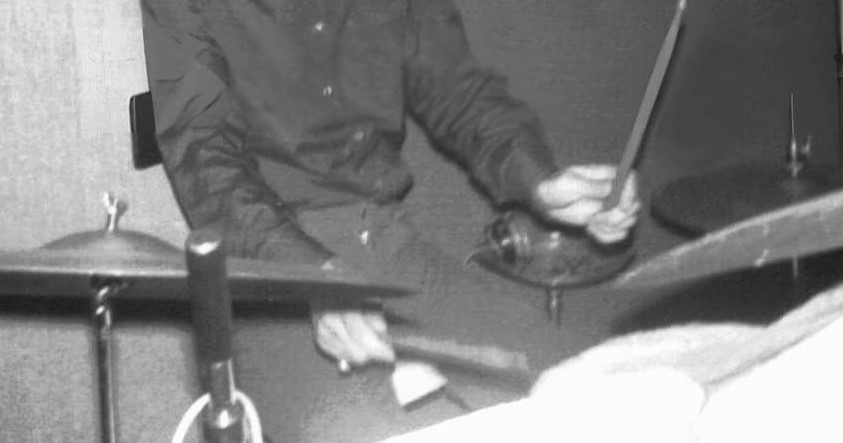 The remaining ten measures comprise the actual guts of the verse with John's lead vocals immediately kicking in and Ringo continually pounding out the full beat on his toms and kick drum with snare drum accents only in measures six, eight, twelve and fourteen, no cymbals being used at all. George slides up and down the neck of his guitar filling in the slight gaps left between John's vocal lines in measures six and eight, and then repeating his rapid-fire chords from the opening riff in measures twelve and fourteen. Paul keeps low profile on the bass but slides appropriately up and down the neck following the pattern set by George. Backing harmonies from John, Paul and George swirl around in the background starting in the seventh measure and continue throughout the verse, harmonizing appropriately in the thirteenth and fourteenth measure with John's “yeah, yeah, yeah” lead vocal line. The remaining ten measures comprise the actual guts of the verse with John's lead vocals immediately kicking in and Ringo continually pounding out the full beat on his toms and kick drum with snare drum accents only in measures six, eight, twelve and fourteen, no cymbals being used at all. George slides up and down the neck of his guitar filling in the slight gaps left between John's vocal lines in measures six and eight, and then repeating his rapid-fire chords from the opening riff in measures twelve and fourteen. Paul keeps low profile on the bass but slides appropriately up and down the neck following the pattern set by George. Backing harmonies from John, Paul and George swirl around in the background starting in the seventh measure and continue throughout the verse, harmonizing appropriately in the thirteenth and fourteenth measure with John's “yeah, yeah, yeah” lead vocal line.
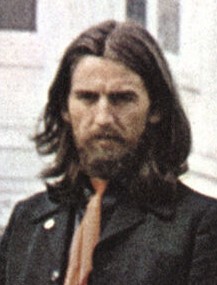 This moves directly into the second fourteen-measure verse which is an exact duplication of the instrumental arrangement as heard in the first verse. One interesting element to look for here is a guitar mistake by George in the eighth measure where he doesn't quite slide up to correct guitar frets as in all the other occurrences in the song. This moves directly into the second fourteen-measure verse which is an exact duplication of the instrumental arrangement as heard in the first verse. One interesting element to look for here is a guitar mistake by George in the eighth measure where he doesn't quite slide up to correct guitar frets as in all the other occurrences in the song.
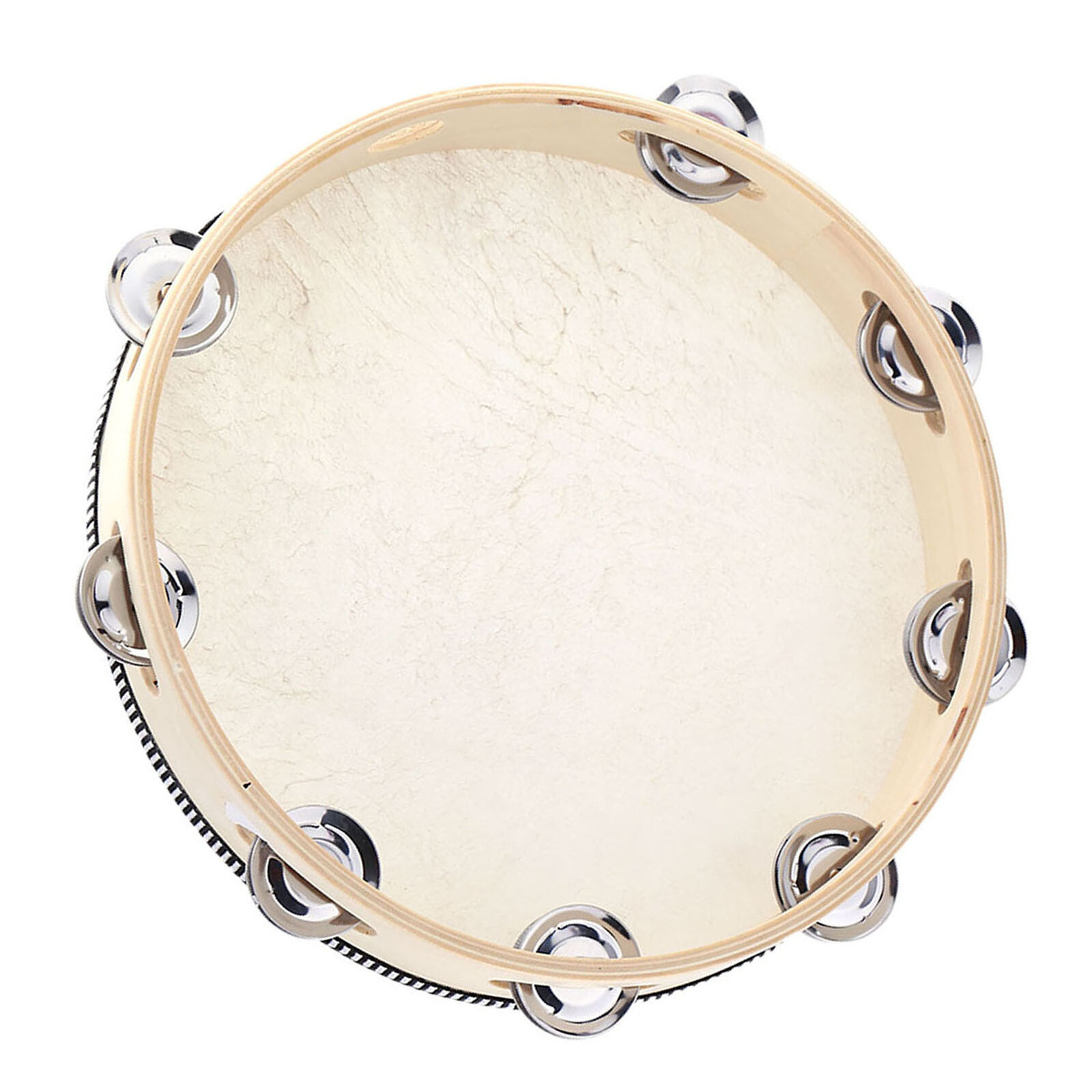 Next comes the final section of the song, which is the twenty-two measure instrumental section. The first four measures are identical to the opening measures of both verses, these consisting of the identifiable riff for the song. The arrangement is the same as before, but with some noticeable differences. One is a subdued voice on the downbeat of the first measure saying “yeah,” undoubtedly an accidental repeat of the “yeah, yeah, yeah” phrase just heard in the final measures of the second verse that proceeds it. Another point of interest is the bass guitar flub from Paul mentioned above, which has been accentuated in the mixing stage by an increase in volume. We also hear percussion accents in measures two and four, Ringo's tambourine, maracas and cowbell kicking in for the first time in the song. Next comes the final section of the song, which is the twenty-two measure instrumental section. The first four measures are identical to the opening measures of both verses, these consisting of the identifiable riff for the song. The arrangement is the same as before, but with some noticeable differences. One is a subdued voice on the downbeat of the first measure saying “yeah,” undoubtedly an accidental repeat of the “yeah, yeah, yeah” phrase just heard in the final measures of the second verse that proceeds it. Another point of interest is the bass guitar flub from Paul mentioned above, which has been accentuated in the mixing stage by an increase in volume. We also hear percussion accents in measures two and four, Ringo's tambourine, maracas and cowbell kicking in for the first time in the song.
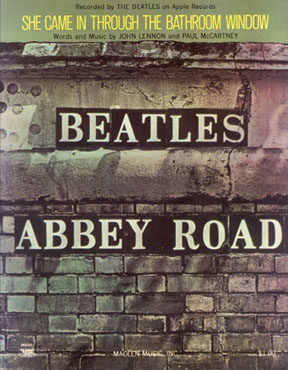 The remaining eighteen measures of this instrumental section consist mostly of the three-chord pattern set by John's acoustic guitar riff played repeatedly while the full instrumentation of the verses takes hold. After John exclaims an indecipherable phrase from his lead vocal track, Ringo's percussion section permeates the remainder of the song while George provides a tasty guitar solo treated with what sounds like a slap-back echo effect. His solo starts in measure six and continues to finish off the song in measure twenty-two. Ringo plods along on drums as heard in the verses while Paul lays down an appropriately energetic bass line, his keyboard overdubs buried in the mix. While John's lead vocal track enters back into the mix, which undoubtedly was recorded onto the same track as Paul's soon-to-be-heard lead vocal, the energetic momentum of the song continues on into the following track, “She Came In Through The Bathroom Window,” which was recorded in tandem with this track as explained above. The remaining eighteen measures of this instrumental section consist mostly of the three-chord pattern set by John's acoustic guitar riff played repeatedly while the full instrumentation of the verses takes hold. After John exclaims an indecipherable phrase from his lead vocal track, Ringo's percussion section permeates the remainder of the song while George provides a tasty guitar solo treated with what sounds like a slap-back echo effect. His solo starts in measure six and continues to finish off the song in measure twenty-two. Ringo plods along on drums as heard in the verses while Paul lays down an appropriately energetic bass line, his keyboard overdubs buried in the mix. While John's lead vocal track enters back into the mix, which undoubtedly was recorded onto the same track as Paul's soon-to-be-heard lead vocal, the energetic momentum of the song continues on into the following track, “She Came In Through The Bathroom Window,” which was recorded in tandem with this track as explained above.
American Releases
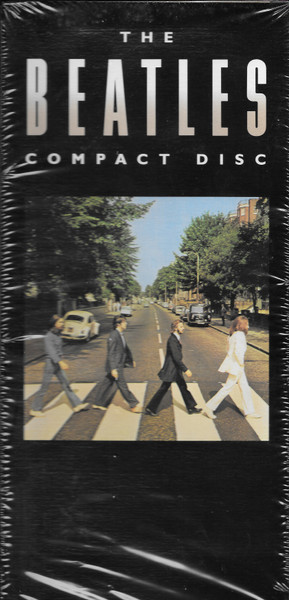 On October 1st, 1969, the final recorded Beatles album was released in America, simply titled "Abbey Road." "Polythene Pam" is the sixth track on side two of the album and the fourth named track of the long medley that fills up the majority of this second side of the album. The "Abbey Road" album took only three weeks to jump into the top spot on the Billboard album chart, raking in a total of eleven weeks in the #1 position. The album first appeared on compact disc on October 10th, 1987, and then as a remastered release on September 9th, 2009. On September 27th, 2019, a 50th Anniversary vinyl and CD version was released with a new vibrant stereo mix created by Giles Martin, not to mention an opaque green vinyl edition coming out on October 10th, 2025 as an exclusive release available only at Target Department Stores. On October 1st, 1969, the final recorded Beatles album was released in America, simply titled "Abbey Road." "Polythene Pam" is the sixth track on side two of the album and the fourth named track of the long medley that fills up the majority of this second side of the album. The "Abbey Road" album took only three weeks to jump into the top spot on the Billboard album chart, raking in a total of eleven weeks in the #1 position. The album first appeared on compact disc on October 10th, 1987, and then as a remastered release on September 9th, 2009. On September 27th, 2019, a 50th Anniversary vinyl and CD version was released with a new vibrant stereo mix created by Giles Martin, not to mention an opaque green vinyl edition coming out on October 10th, 2025 as an exclusive release available only at Target Department Stores.
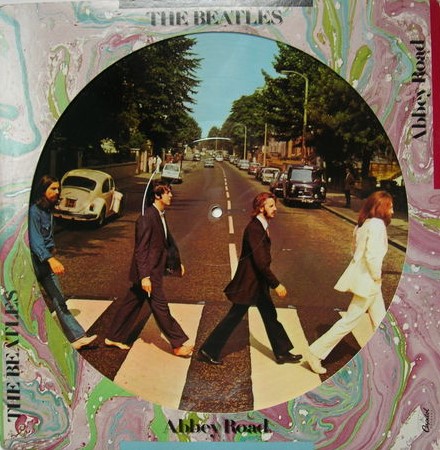 Sometime in 1978, Capitol re-released the “Abbey Road” album as a picture disc. Side one had the iconic front cover while side two contained a close-up of the wall photo of the back cover minus the song title listings. This release quickly went out of print, but was re-released on 180-gram vinyl on September 27th, 2019 for its 50th Anniversary. Sometime in 1978, Capitol re-released the “Abbey Road” album as a picture disc. Side one had the iconic front cover while side two contained a close-up of the wall photo of the back cover minus the song title listings. This release quickly went out of print, but was re-released on 180-gram vinyl on September 27th, 2019 for its 50th Anniversary.
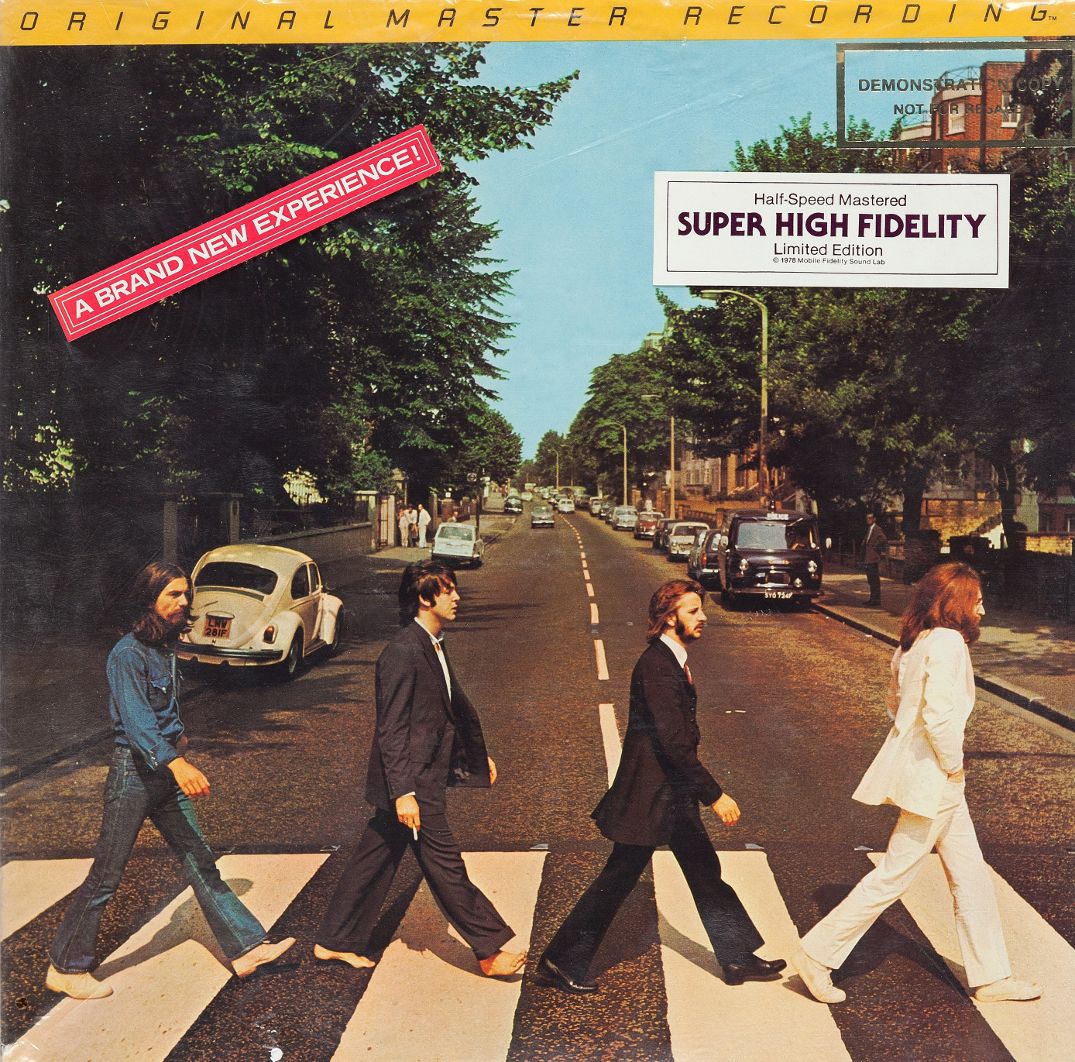 An interesting US vinyl edition of “Abbey Road” was released on December 28th, 1979, this being manufactured by Mobile Fidelity Sound Lab in Chatsworth, California as the first Beatles installment in their "Original Master Recording" series. Their practice was to prepare a new master utilizing half-speed mastering technology from the original master tapes, in this case using the leased sub-master from Capitol Records. Stickers on the shrinkwrap proclaimed this album as being “A Brand New Experience,” which proved to be the case. This version of the album sounded superior to all previous British and American pressings at that time. Unfortunately, this excellent edition of “Abbey Road” was only available for a short time and is quite collectible today. An interesting US vinyl edition of “Abbey Road” was released on December 28th, 1979, this being manufactured by Mobile Fidelity Sound Lab in Chatsworth, California as the first Beatles installment in their "Original Master Recording" series. Their practice was to prepare a new master utilizing half-speed mastering technology from the original master tapes, in this case using the leased sub-master from Capitol Records. Stickers on the shrinkwrap proclaimed this album as being “A Brand New Experience,” which proved to be the case. This version of the album sounded superior to all previous British and American pressings at that time. Unfortunately, this excellent edition of “Abbey Road” was only available for a short time and is quite collectible today.
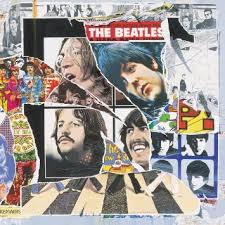 October 28th, 1996 was the release date for the album “Anthology 3” which contains the original demo of “Polythene Pam” that John recorded at George's 'Kinfauns' home on May 28th, 1968. George Martin and Geoff Emerick thought to include a sampling of seven songs that The Beatles recorded as demos on this and the following day, four of which were Lennon compositions, for this interesting compilation album. October 28th, 1996 was the release date for the album “Anthology 3” which contains the original demo of “Polythene Pam” that John recorded at George's 'Kinfauns' home on May 28th, 1968. George Martin and Geoff Emerick thought to include a sampling of seven songs that The Beatles recorded as demos on this and the following day, four of which were Lennon compositions, for this interesting compilation album.
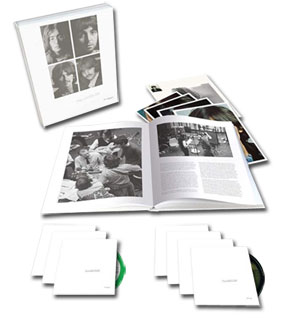 The 'Kinfauns' demo of "Polythene Pam" was also included in certain editions of the "White Album" for its 50th Anniversary, since the song was originally intended as a contender for this album. It was contained in the "Deluxe" edition, which was made available as a 3CD set and a limited-edition 4LP vinyl set, as well as the "Super Deluxe" 6CD + Blu-ray set, both of which were released on November 9th, 2018. The 'Kinfauns' demo of "Polythene Pam" was also included in certain editions of the "White Album" for its 50th Anniversary, since the song was originally intended as a contender for this album. It was contained in the "Deluxe" edition, which was made available as a 3CD set and a limited-edition 4LP vinyl set, as well as the "Super Deluxe" 6CD + Blu-ray set, both of which were released on November 9th, 2018.
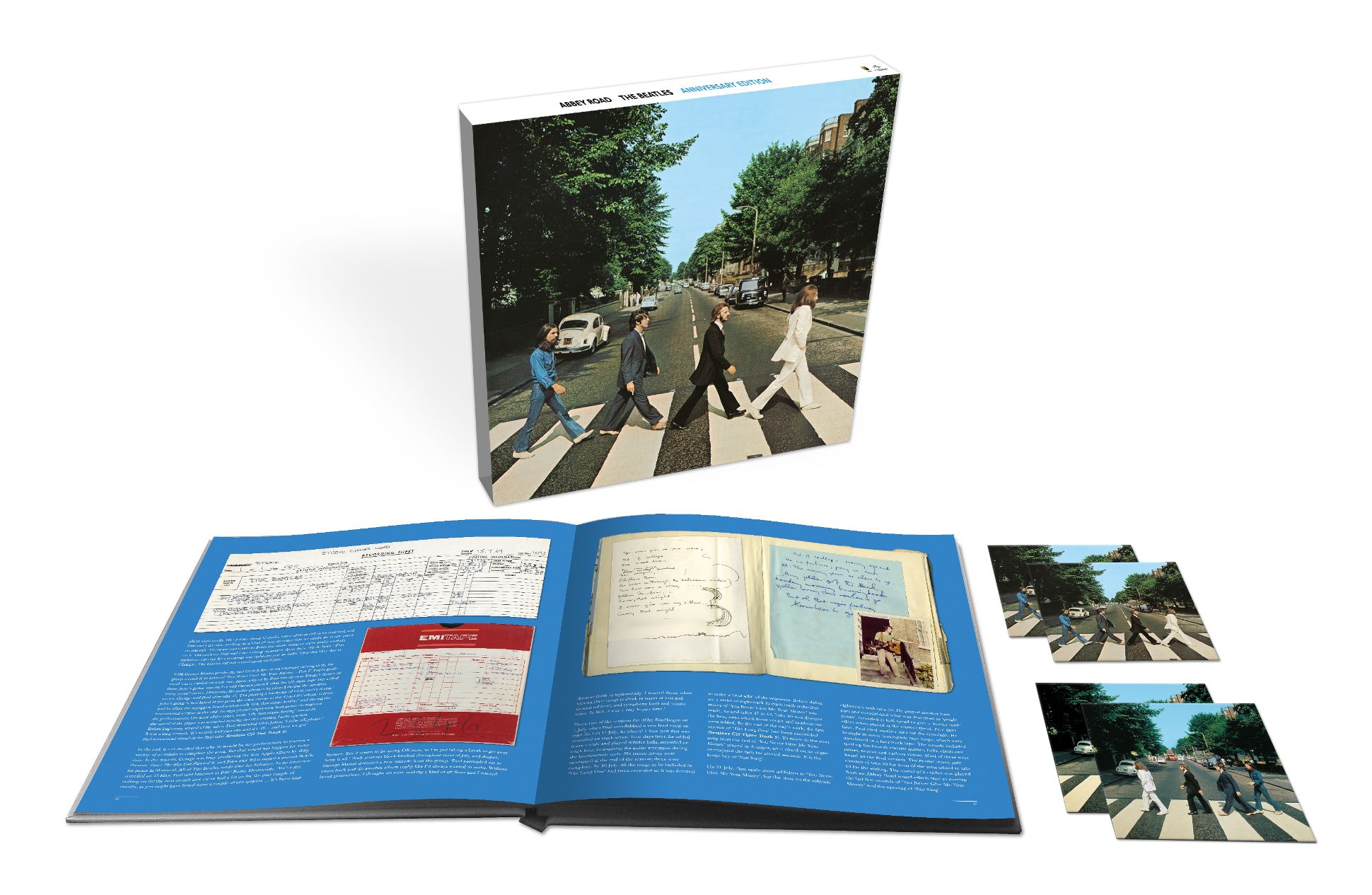 On September 27th, 2019, various other editions of "Abbey Road" were released in connection with its 50th Anniversary. The "Deluxe" 2CD set contains the new Giles Martin mix of the entire album as well as the never-before-heard 'take 27' of "Polythene Pam" as recorded on July 25th, 1969. The "Triple Album" vinyl set and the "Super Deluxe" 3CD + Blu-ray edition contain these tracks as well, along with the July 30th, 1969 trial edit and mix of the entire "Abbey Road" medley, as described above, which contains "Polythene Pam" as it was recorded up to that point. On September 27th, 2019, various other editions of "Abbey Road" were released in connection with its 50th Anniversary. The "Deluxe" 2CD set contains the new Giles Martin mix of the entire album as well as the never-before-heard 'take 27' of "Polythene Pam" as recorded on July 25th, 1969. The "Triple Album" vinyl set and the "Super Deluxe" 3CD + Blu-ray edition contain these tracks as well, along with the July 30th, 1969 trial edit and mix of the entire "Abbey Road" medley, as described above, which contains "Polythene Pam" as it was recorded up to that point.
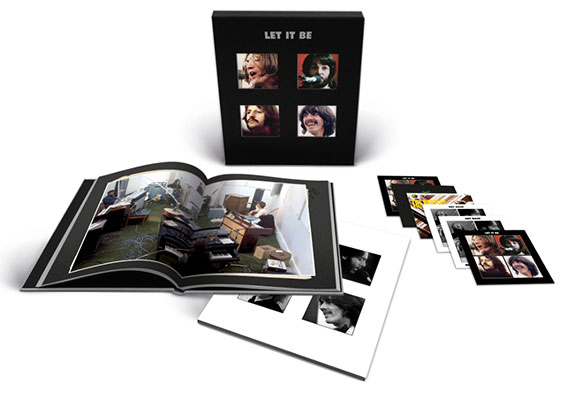 On October 15th, 2021, various editions of the "Let It Be" album were released, some of which featuring an interesting version of "Polythene Pam." The "Super Deluxe" 5CD + Blu-ray edition and the "Super Deluxe" 4LP + 1 12" EP edition include a rehearsal of the song as recorded on January 24th, 1969 at their Apple Studio after they'd all ordered lunch from the Apple kitchen. On October 15th, 2021, various editions of the "Let It Be" album were released, some of which featuring an interesting version of "Polythene Pam." The "Super Deluxe" 5CD + Blu-ray edition and the "Super Deluxe" 4LP + 1 12" EP edition include a rehearsal of the song as recorded on January 24th, 1969 at their Apple Studio after they'd all ordered lunch from the Apple kitchen.
Live Performances
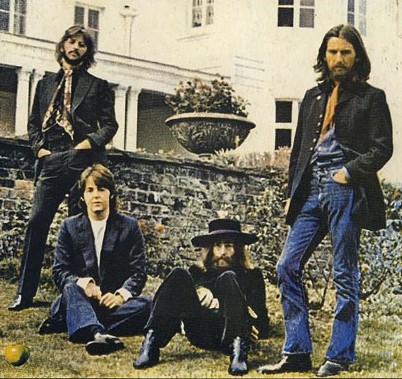 The last time that all four Beatles were even in the same room together was apparently in the late fall of 1969, which was way past their touring days. Therefore, neither “Polythene Pam” nor any other portion of the “Abbey Road” medley were performed by the group on any stage, and no individual group member ever thought to perform this track either. The last time that all four Beatles were even in the same room together was apparently in the late fall of 1969, which was way past their touring days. Therefore, neither “Polythene Pam” nor any other portion of the “Abbey Road” medley were performed by the group on any stage, and no individual group member ever thought to perform this track either.
Conclusion
"Polythene Pam," along with its counterpart "She Came In Through The Bathroom Window" which was recorded right along with it, arguably comprise the most energetic and rocking segment of the entire "Abbey Road" medley. Apart from the climactic closing track entitled "The End," "Polythene Pam" was a definite high-point, endorsed enthusiastically by fellow band mate George Harrison.
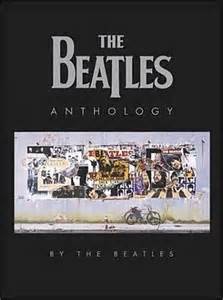 During the “Beatles Anthology” interviews, he stated: “I liked 'Polythene Pam' because of its Liverpool-ness – 'She's the kind of a gail that makes the “News Of The Waild,” yes, you could say she was attrrrractively built.' Nobody writes, kind of, comic stuff but that still has a certain seriousness about it. Like 'Polythene Pam' was like a really good rock 'n' roll song really but, you know, it bothers me sometimes when something so obviously funny and nobody laughs and nobody ever gets it.” During the “Beatles Anthology” interviews, he stated: “I liked 'Polythene Pam' because of its Liverpool-ness – 'She's the kind of a gail that makes the “News Of The Waild,” yes, you could say she was attrrrractively built.' Nobody writes, kind of, comic stuff but that still has a certain seriousness about it. Like 'Polythene Pam' was like a really good rock 'n' roll song really but, you know, it bothers me sometimes when something so obviously funny and nobody laughs and nobody ever gets it.”
Song Summary
“Polythene Pam”
Written by: John Lennon / Paul McCartney
- Song Written: March 1968
- Song Recorded: July 25, 28 & 30, 1969
- First US Release Date: October 1, 1969
- First US Album Release: Apple #SO-383 “Abbey Road”
- British Album Release: Apple #PCS 7088 “Abbey Road”
- US Single Release: n/a
- Highest Chart Position: n/a
- Length: 1:13
- Key: E major
- Producer: George Martin
- Engineers: Geoff Emerick, Phil McDonald, John Kurlander
Instrumentation (most likely):
- John Lennon - Lead and Backing Vocals, Rhythm Guitar (1964 Framus Hootenanny 5/024 Acoustic 12-string)
- Paul McCartney - Bass (1964 Rickenbacker 4001 S ), Piano (1905 Steinway Vertegrand), Electric Piano (1968 Fender Rhodes Seventy-Three Sparkle Top), harmony vocals
- George Harrison - Lead Guitars (1957 Gibson Les Paul Standard, 1968 Fender Rosewood Telecaster), backing vocals
- Ringo Starr - Drums (1968 Ludwig Hollywood Maple), tambourine, maracas, cowbell
Written and compiled by Dave Rybaczewski
|
IF YOU WOULD LIKE TO MAKE A DONATION TO KEEP THIS WEBSITE UP AND RUNNING, PLEASE CLICK BELOW!
Sign Up Below for our MONTHLY BEATLES TRIVIA QUIZ!
|